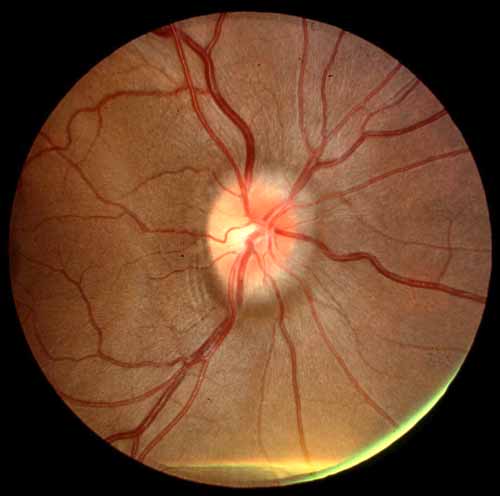I was still a somewhat green Optometrist, about a year out of graduation, when a young, healthy 15 year old girl sat in my exam chair. Her medical history was unremarkable (as a majority of young people's medical histories would be), but she complained that she felt her eyes weren't focusing quite right at the end of the day in her contacts or glasses. She also was complaining of persistent headaches that seemed unrelated to her eyes.
A lot of times, patients who have uncorrected far sighted problems will pass all tests at a pediatrician screening, DMV visit, or even nurse's office check, but will have end of day headaches for doing too much focusing. This can cause difficulty focusing during school and an aversion to reading to avoid the impending headache.
When looking in the back of the eye, this is what I saw in both eyes:
 This is a swollen optic nerve and can arise from many different things including a tumor behind the eyeball or 'fluid on the brain.' There are probably not many times I wish for 'fluid on the brain', but this is one of those cases. The patient was seen in the following days by a neurologist for an MRI of the brain and orbit both with and without contrast. Thankfully, the MRI came back normal, but we still had the reduced vision and the headaches to consider. Typically, when a patient is seen for this combination of symptoms, a spinal tap will then be done to rule out 'fluid on the brain.' Sure enough, the patient's intracranial (inside the head) pressure was elevated. Because there was no discernible cause, it was considered Idiopathic. This patient was ordered to decrease body weight and begin taking a medication called Diamox to reduce the cerebrospinal fluid.
This is a swollen optic nerve and can arise from many different things including a tumor behind the eyeball or 'fluid on the brain.' There are probably not many times I wish for 'fluid on the brain', but this is one of those cases. The patient was seen in the following days by a neurologist for an MRI of the brain and orbit both with and without contrast. Thankfully, the MRI came back normal, but we still had the reduced vision and the headaches to consider. Typically, when a patient is seen for this combination of symptoms, a spinal tap will then be done to rule out 'fluid on the brain.' Sure enough, the patient's intracranial (inside the head) pressure was elevated. Because there was no discernible cause, it was considered Idiopathic. This patient was ordered to decrease body weight and begin taking a medication called Diamox to reduce the cerebrospinal fluid.
Most changes to the optic nerve (like Glaucoma) cause a change in vision starting with the peripheral (or side) vision before it affects central vision. This patient had already lost significant peripheral vision and the vision loss was beginning to encroach on her central vision and was beginning to make tasks difficult. Luckily, with the decrease in pressure, the vision started to slowly return. This does not always happen and had this patient waited longer, she may have lost more vision.

